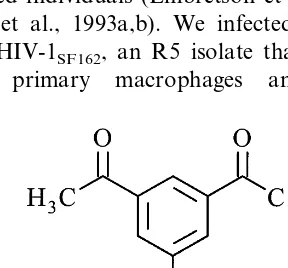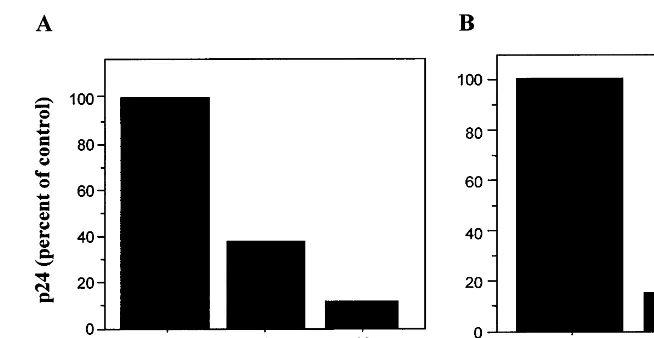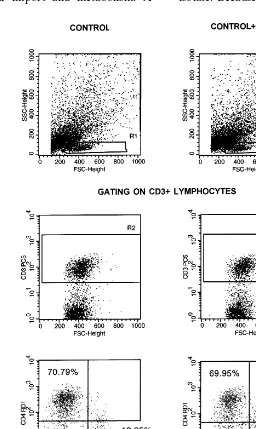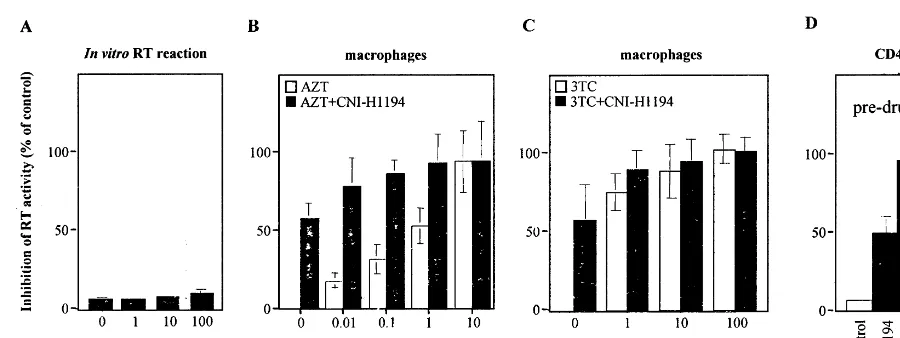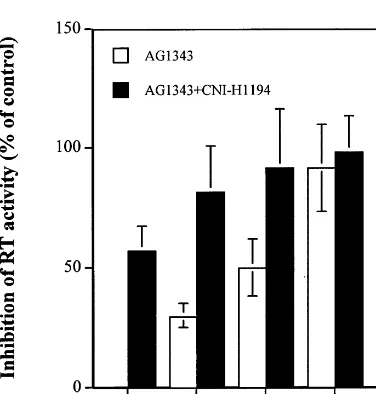Small molecule inhibitor of HIV-1 nuclear import
suppresses HIV-1 replication in human lymphoid tissue ex
vivo: a potential addition to current anti-HIV
drug repertoire
Svetlana Glushakova
a, Larisa Dubrovsky
b, Jean-Charles Grivel
a,
Omar Haffar
c, Michael Bukrinsky
b,*
aThe Laboratory of Cellular and Molecular Biophysics,NICHD,NIH,Bethesda,MD 20892, USA bPicower Institute for Medical Research,350Community Dri6e,Manhasset,NY 11030 USA
cInternational Therapeutics Inc.,Seattle,WA 98122, USA
Received 21 December 1999; accepted 29 March 2000
Abstract
Despite recent progress in anti-HIV therapy, which has to do mainly with introduction of protease inhibitors into clinical practice, drug toxicity and emergence of drug-resistant isolates during the long-term treatment of the patients necessitates search for new drugs that can be added to currently used components of a multi-drug cocktail in highly active anti-retroviral therapy (HAART). Recently, we described a class of arylene bis(methylketone) compounds that inhibit nuclear import of HIV-1 pre-integration complexes and suppress viral replication in macrophages and PBMC in vitro. In this report, we demonstrate that one of these compounds, CNI-H1194, inhibited HIV-1 replication in primary lymphoid tissue ex vivo. The compound did not antagonize the activity of currently used anti-HIV drugs that inhibit viral reverse transcriptase or protease. These results suggest that arylene bis(methylketone) compounds might be a valuable addition to HAART. © 2000 Elsevier Science B.V. All rights reserved.
Keywords:Nuclear import inhibitor; Lymphoid tissue; Histoculture; Reverse transcriptase
www.elsevier.com/locate/antiviral
The step of nuclear translocation of the HIV-1 pre-integration complex (PIC) is essential for viral replication as it allows the PIC to get into contact with the cellular chromatin. In
non-prolif-erating cells, such as terminally differentiated macrophages, this process is driven by an interac-tion between the viral PIC proteins carrying spe-cific nuclear localization signals (NLSs), namely matrix antigen (MA) and integrase (IN), and the cellular nuclear import machinery (for recent re-views see Bukrinsky and Haffar, 1997, 1998; Fouchier and Malim, 1999). In rapidly dividing cells, such as mitogen-stimulated T cells, in
addi-* Corresponding author. Fax: +1-516-3650286.
E-mail address:[email protected] (M. Bukrinsky).
pound under conditions more closely resembling in vivo situation than those used in tissue culture studies. This was especially important in view of the data indicating that most of the virus detected in the blood of HIV-infected patients comes from T lymphocytes (Perelson et al., 1996, 1997), which might be resistant to the effect of nuclear import inhibitors due to high level of activation and proliferation. CNI-H1194 inhibits HIV-1 replica-tion in lymphoid histocultures.
A recently developed system for culturing hu-man tonsil tissue (Glushakova et al., 1995, 1997) provided an opportunity to test the anti-HIV activity of the compound in the context of intact lymphoid tissue, which is believed to be the main reservoir of replicating HIV-1 in the body of infected individuals (Embretson et al., 1993; Pan-taleo et al., 1993a,b). We infected tissue blocks with HIV-1SF162, an R5 isolate that replicates in
both primary macrophages and CD4+ T
tures (Fig. 3). Such analysis truly represents the situation within intact tissue blocks with regard to cell numbers (Grivel and Margolis, 1999). Note that the number of live T cells and the CD4+/ CD8+ratios in drug-treated and control histocul-tures (5.53 and 5.47, respectively) were very similar. This is consistent with the notion of quan-titative preservation of the main T cell subsets in drug-treated histocultures.
HIV-1 replication in lymphoid tissue occurs predominantly in CD4+ T lymphocytes (Glushakova et al., 1999); however, in contrast to PHA-stimulated PBMC cultures, human tonsil system supports productive HIV-1 infection in the absence of exogenous stimulation or activation (Glushakova et al., 1995) and therefore the rate of T cell proliferation in this system is limited. Under such conditions, viral nuclear access depends on active transport of the PIC through the intact nuclear membrane, thus explaining sensitivity to CNI-H1194. This result, together with recent re-ports demonstrating that non-proliferating, par-tially activated T cells might represent a residual reservoir of replicating virus in highly active anti-retroviral therapy (HAART)-treated patients (Finzi et al., 1997; Zhang et al., 1999), supports the notion that HIV-1 nuclear import may present an attractive target for anti-HIV therapeutics. CNI-H1194 does not antagonize RT inhibitors.
While the main mechanism of action of arylene bis(methylketone) compounds is inactivation of basic-type NLSs in MA and, presumably, IN through formation of reversible Schiff bases with lysine residues (Dubrovsky et al., 1995), the
Fig. 2. Anti-HIV activity of CNI-H1194 in histocultures of human tonsils. Human tonsils were obtained from patients undergoing tonsillectomy. Tissues were dissected into 2-mm blocks and incubated on the top of collagen gels at the air – liquid interface (histoculture) as described in detail before (Glushakova et al., 1995, 1997, 1999). The CNI-H1194 drug was added to the medium 3 h prior to infection and was replenished with each medium change. Tissue blocks were infected by slowly applying 3ml of clarified
virus-containing medium on the top of each tissue block. For each experiment, supernatants from 20 tissue blocks (this number was found empirically to produce statistically reliable data (Glushakova et al., 1995, 1997, 1999)) obtained from the same donor were pooled and used for p24 analysis (measured by ELISA). Panel A: Dose-dependent effect of CNI-H1194 on HIV-1SF162replication
in human lymphoid tissue ex vivo. Shown is the amount of p24 antigen (as a percent of p24 in treated versus untreated, control cultures) in the pooled culture medium from 20 tissue blocks from an individual donor, produced over a 14-day incubation. Total amount of p24 produced by control blocks was 43.62 ng. Panel B: The effect of CNI-H1194 (10mM) on HIV-1SF162replication in
lymphoid tissue from three different donors. The data are presented as a percent of p24 produced by drug-treated tissue blocks relative to non-treated control cultures and are mean9S.E.M. of three experiments with tissues from different donors.
tivity for HIV-1-derived NLSs appeared to come from the ability of the compounds to bind to reverse transcriptase (RT) and thus accumulate in the PIC (Popov et al., 1996). This interaction with RT might involve the same site as used by such RT inhibitors as AZT or 3TC, and thus might preclude the use of NLS inhibitors as additions to current formulations of HAART. In our previous study (Dubrovsky et al., 1995), another com-pound from the same group, CNI-H0293, did not significantly reduce the amount of reverse tran-scription products produced in an HIV-1-infected cell, suggesting that the compound does not in-hibit RT activity. A similar result was obtained with CNI-H1194 (not shown). To measure di-rectly the effect of the compound on HIV-1 RT activity, we added different concentrations of CNI-H1194 to the in vitro RT reaction performed with supernatant of HIV-1-infected culture. As shown in Fig. 4A, no inhibitory activity of the compound was observed at concentrations up to
100 mM, supporting our previous conclusion that the anti-HIV activity of this class of compounds does not involve RT inhibition (Popov et al., 1996).
Fig. 3. The effect of CNI-H1194 on T cell subsets in histocultures of human tonsils. Histocultures were prepared as described in the legend to Fig. 2. Two sets of 20 tissue blocks each were cultured with or without addition of 10mM of CNI-H1194. Cells were
Fig. 4. Anti-HIV activity of CNI-H1194 combination with reverse transcriptase inhibitors. Panel A: Indicated concentrations of CNI-H1194 were added to in vitro reverse transcription reaction performed with a supernatant of HIV-infected culture. Results show mean of three measurements9S.D. Panels B, C: Cultures of primary macrophages were prepared from peripheral blood of HIV-seronegative donors as described previously (Schmidtmayerova et al., 1997) and infected with a macrophage-tropic HIV-1 strain ADA. Cells were cultured without addition of the drugs or in the presence of indicated concentrations of reverse transcriptase inhibitors AZT (panel A) or 3TC (panel B) with or without 100 nM of CNI-H1194. RT activity in culture supernatants was assayed at various intervals after infection. Results are presented as a reduction of RT activity in treated versus untreated (control) cultures on day 11 after infection. Similar numbers were obtained at other time points. The data are presented as mean of three independent wells, and error bars show standard error. Panel D: PHA-activated CD8+T cell-depleted PBMC were incubated for 10 days in IL-2 and infected with AZT-resistant virus A012 G691-2 (post-drug) or its parental isolate A012 G762-3 (pre-drug) in the absence (control) or presence of 1mM of AZT or 10mM of CNI-H1194. RT activity in triplicate culture supernatants was evaluated on day
10 after infection and is presented as a mean reduction of RT activity in treated versus control cultures9S.D.
macrophage cultures, the analysis was performed in CD4+ T lymphocytes. To allow these cells to return to a semi-quiescent state after in vitro activation and thus to partially avoid the negative effect of cell proliferation on CNI-H1194 activity, we performed infections after incubating activated cells for 10 days in IL-2 (Kinoshita et al., 1998). Under thses conditions we obtained a 50% inhibi-tion of the pre-drug isolate using 10mM concen-tration of CNI-H1194, while AZT (1mM) almost completely inhibited virus replication (Fig. 4D). However, CNI-H1194 was as effective in inhibit-ing pre-virus as post-virus, while AZT was not. Indeed, replication of AZT-resistant isolate was inhibited by AZT by only 30%, while CNI-H1194 demonstrated the same inhibitory activity as ob-served with the parental, AZT-sensitive, virus (Fig. 4D). These results indicate that arylene bis(-methylketone) compounds, despite their binding to RT (Popov et al., 1996), do not antagonize the effect of nucleoside inhibitors of RT. One possible explanation of this result is that CNI-H1194 and
RT inhibitors interact with different parts of the RT molecule. This interpretation is consistent with negligible activity of CNI-H1194 as a RT inhibitor and suggests that CNI-H1194 binds to RT outside of the active center.
CNI-H1194 potentiates the effect of protease inhibitor. In addition to RT inhibitors, inhibitors of HIV protease are important components of the drug cocktail used in HAART. We therefore tested anti-HIV activity of a combination of CNI-H1194 and nelfinavir, a protease inhibitor kindly provided by Agouron Pharmaceuticals, Inc. (La Jolla, CA). As shown in Fig. 5, the presence of CNI-H1194 at a 100-nM concentration (EC50)
substantially potentiated the anti-HIV activity of nelfinavir. Again, cell viability in uninfected drug-treated cultures was :98%. Although virus repli-cation varied significantly in cultures prepared from peripheral blood of different donors, the inhibitory effect was rather consistent.
Fig. 5. Anti-HIV activity of CNI-H1194 combination with protease inhibitor. Experiment was performed with macrophage cultures infected with HIV-1ADAas described in
Fig. 4, except that protease inhibitor nelfinavir (AG1343) was used instead of RT inhibitors.
Embretson, J., Zupancic, M., Ribas, J.L., Burke, A., Racz, P., Tenner-Racz, K., Haase, A.T., 1993. Massive covert infec-tion of helper T lymphocytes and macrophages by HIV during the incubation period of AIDS. Nature 362, 359 – 362.
Finzi, D., Hermankova, M., Pierson, T., Carruth, L.M., Buck, C., Chaisson, R.E., Quinn, T.C., Chadwick, K., Mar-golick, J., Brookmeyer, R., Gallant, J., Markowitz, M., Ho, D.D., Richman, D.D., Siliciano, R.F., 1997. Identifi-cation of a reservoir for HIV-1 in patients on highly active antiretroviral therapy. Science 278, 1295 – 1300.
Fouchier, R.A., Malim, M.H., 1999. Nuclear import of human immunodeficiency virus type-1 preintegration complexes. Adv. Virus Res. 52, 275 – 299.
Glushakova, S., Baibakov, B., Margolis, L.B., Zimmerberg, J., 1995. Infection of human tonsil histocultures: a model for HIV pathogenesis. Nat. Med. 1, 1320 – 1322.
Glushakova, S., Baibakov, B., Zimmerberg, J., Margolis, L.B., 1997. Experimental HIV infection of human lymphoid tissue: correlation of CD4+ T cell depletion and virus syncytium-inducing/non-syncytium-inducing phenotype in histocultures inoculated with laboratory strains and patient isolates of HIV type 1. AIDS Res. Hum. Retroviruses 13, 461 – 471.
Glushakova, S., Grivel, J.C., Suryanarayana, K., Meylan, P., Lifson, J.D., Desrosiers, R., Margolis, L., 1999. Nef en-hances human immunodeficiency virus replication and re-sponsiveness to interleukin-2 in human lymphoid tissue ex vivo. J. Virol. 73, 3968 – 3974.
Grivel, J.C., Margolis, L.B., 1999. CCR5- and CXCR4-tropic HIV-1 are equally cytopathic for their T-cell targets in human lymphoid tissue. Nat. Med. 5, 344 – 346.
Haffar, O.K., Smithgall, M.D., Popov, S., Ulrich, P., Bruce, A.G., Nadler, S.G., Cerami, A., Bukrinsky, M.I., 1998. CNI-H0294, a nuclear importation inhibitor of the human immunodeficiency virus type 1 genome, abrogates virus replication in infected activated peripheral blood mononu-clear cells. Antimicrob. Agents Chemother. 42, 1133 – 1138. Kinoshita, S., Chen, B.K., Kaneshima, H., Nolan, G.P., 1998. Host control of HIV-1 parasitism in T cells by the nuclear factor of activated T cells. Cell 95, 595 – 604.
class of compounds might further improve the potency of HAART. The step of nuclear import follows reverse transcription and precedes integra-tion, and the product of each reaction is the immediate substrate for the subsequent one. Therefore, one can expect a cooperative effect of RT, IN, and nuclear import inhibitors. Addition of the latter two classes of compounds to cur-rently used anti-HIV drug cocktails may help achieve a complete long-term suppression of viral replication.
Acknowledgements
Pantaleo, G., Graziosi, C., Demarest, J.F., Butini, L., Mon-troni, M., Fox, C.H., Orenstein, J.M., Kotler, D.P., Fauci, A.S., 1993. HIV infection is active and progressive in lymphoid tissue during the clinically latent stage of disease. Nature 362, 355 – 358.
Pantaleo, G., Graziosi, C., Fauci, A.S., 1993. The role of lymphoid organs in the pathogenesis of HIV infection. Semin. Immunol. 5, 157 – 163.
Perelson, A.S., Essunger, P., Ho, D.D., 1997. Dynamics of HIV-1 and CD4+ lymphocytes in vivo. AIDS 11 (Suppl. A), S17 – S24.
Perelson, A.S., Neumann, A.U., Markowitz, M., Leonard, J.M., Ho, D.D., 1996. HIV-1 dynamics in vivo: virion clearance rate, infected cell life-span, and viral generation time. Science 271, 1582 – 1586.
Popov, S., Dubrovsky, L., Lee, M.A., Pennathur, S., Haffar,
O., aL-Abed, Y., Tonge, P., Ulrich, P., Rexach, M., Blo-bel, G., Cerami, A., Bukrinsky, M., 1996. Critical role of reverse transcriptase in the inhibitory mechanism of CNI-H0294 on HIV-1 nuclear translocation. Proc. Natl. Acad. Sci. USA 93, 11859 – 11864.
Schmidtmayerova, H., Nuovo, G.J., Bukrinsky, M., 1997. Cell proliferation is not required for productive HIV-1 infection of macrophages. Virology 232, 379 – 384.
Zhang, Z., Schuler, T., Zupancic, M., Wietgrefe, S., Staskus, K.A., Reimann, K.A., Reinhart, T.A., Rogan, M., Cavert, W., Miller, C.J., Veazey, R.S., Notermans, D., Little, S., Danner, S.A., Richman, D.D., Havlir, D., Wong, J., Jor-dan, H.L., Schacker, T.W., Racz, P., Tenner-Racz, K., Letvin, N.L., Wolinsky, S., Haase, A.T., 1999. Sexual transmission and propagation of SIV and HIV in resting and activated CD4(+) T cells. Science 286, 1353 – 1357.
